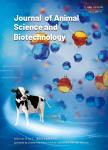Profiling of miRNAs in porcine Sertoli cells
Profiling of miRNAs in porcine Sertoli cells作者机构:College of Biological Science and EngineeringShaanxi University of TechnologyHanzhong 723001China Key Laboratory of Animal GeneticsBreeding and Reproduction of the Ministry of AgricultureCollege of Animal Science and TechnologyNorthwest A&F UniversityYangling 712100ShaanxiChina College of Life ScienceNorthwest A&F UniversityYangling 712100ShaanxiChina.
出 版 物:《Journal of Animal Science and Biotechnology》 (畜牧与生物技术杂志(英文版))
年 卷 期:2021年第12卷第1期
页 面:236-249页
核心收录:
学科分类:0905[农学-畜牧学] 09[农学] 090501[农学-动物遗传育种与繁殖]
基 金:supported in part by the National Natural Science Foundation of China (Grant No. 31572401 31772605) to W.Z
主 题:MicroRNAs Pig Sertoli cell Spermatogenesis TRAF3
摘 要:Background: Sertoli cells(SCs) create a specialized environment to support and dictate ***(miRNAs), a kind of ~ 22 nt small noncoding RNAs, have been reported to be highly abundant in mouse SCs and play critical roles in spermatogenesis. However, the miRNAs of porcine SCs remain largely ***: We isolated porcine SCs and conducted small RNA sequencing. By comparing miRNAs in germ cells, we systematically analyzed the miRNA expression pattern of porcine SCs. We screened the highly enriched SC miRNAs and predicted their functions by Gene Ontology analysis. The dual luciferase assay was used to elucidate the regulation of tumor necrosis factor receptor(TNFR)-associated factor 3(TRAF3) by ***: The analysis showed that 18 miRNAs were highly expressed in SCs and 15 miRNAs were highly expressed in germ cells. These miRNAs were predicted to mediate SC and germ cell functions. In addition, ssc-miR-149 played critical roles in SCs by targeting ***: Our findings provide novel insights into the miRNA expression pattern and their regulatory roles of porcine SCs.



